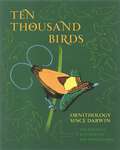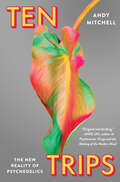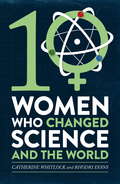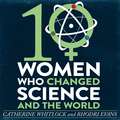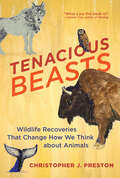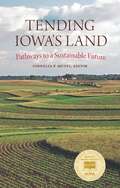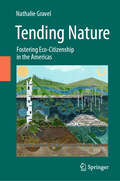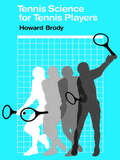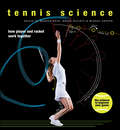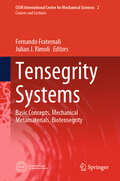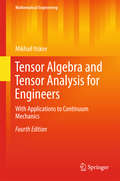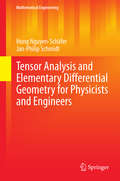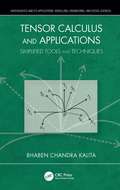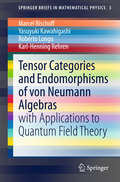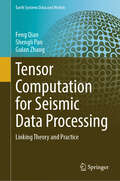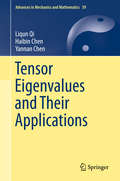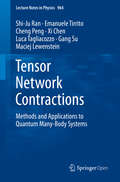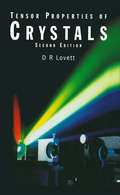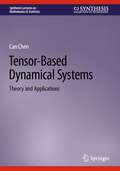- Table View
- List View
Ten Thousand Birds: Ornithology since Darwin
by Tim Birkhead Bob Montgomerie Jo WimpennyTen Thousand Birds provides a thoroughly engaging and authoritative history of modern ornithology, tracing how the study of birds has been shaped by a succession of visionary and often-controversial personalities, and by the unique social and scientific contexts in which these extraordinary individuals worked. This beautifully illustrated book opens in the middle of the nineteenth century when ornithology was a museum-based discipline focused almost exclusively on the anatomy, taxonomy, and classification of dead birds. It describes how in the early 1900s pioneering individuals such as Erwin Stresemann, Ernst Mayr, and Julian Huxley recognized the importance of studying live birds in the field, and how this shift thrust ornithology into the mainstream of the biological sciences. The book tells the stories of eccentrics like Colonel Richard Meinertzhagen, a pathological liar who stole specimens from museums and quite likely murdered his wife, and describes the breathtaking insights and discoveries of ambitious and influential figures such as David Lack, Niko Tinbergen, Robert MacArthur, and others who through their studies of birds transformed entire fields of biology. Ten Thousand Birds brings this history vividly to life through the work and achievements of those who advanced the field. Drawing on a wealth of archival material and in-depth interviews, this fascinating book reveals how research on birds has contributed more to our understanding of animal biology than the study of just about any other group of organisms.
Ten Trips: The New Reality of Psychedelics
by Andy MitchellThe more we learn about psychedelics, the less we seem to understand them. . . . In this engrossing, sometimes hilarious, always dramatic chronicle, a neuropsychologist deflates the hype, explores the limitless possibilities, and reveals a much-needed perspective about psychedelics, giving us a scientist’s first-person experiment with ten different compounds in ten different settings. Once demonized and still largely illegal, psychedelic drugs are now officially a “breakthrough therapy” in treating mental illness, used to heal trauma, conquer addiction, and enhance well-being. But as Andy Mitchell reveals, this approach to psychedelics is overhyped, and most importantly, neglects what is so unusual and valuable about them: the psychedelic experience itself.In Ten Trips, Mitchell takes ten different drugs in ten diverse locations—including a neuroimaging lab in London, the Columbian Andes, Silicon Valley and his friend’s basement kitchen—to document their remarkable effects. Along the way he encounters a cast of distinctive characters: scientists and gangsters, venture capitalists and philosophers, psychonauts and shamans, musicians, monks, therapists, poets, and conmen. His experience opens a doorway to psychedelics’ full potential: for healing and trauma, for ecstatic one-ness and utter terror, for transcendence and corruption, for profundity and laughter.Mitchell argues that by removing psychedelics from their cultures and rituals, both indigenous and underground, we risk rejecting the expertise and the contexts which hold the key to understanding them—and from which their real benefits may derive. In the drive to standardize, control, and monetize the psychedelic experience, we may ultimately destroy what makes them potent: their ability to transform our whole perspective on mental health and reenchant us with the world.A hallucinogenic experience nearly as mind-blowing as actually taking psychedelics themselves, Ten Trips is Michael Pollan’s How to Change Your Mind written by Hunter S. Thompson with a PhD in neuroscience—a perception-altering odyssey that will change the way we see these substances and the world.
Ten Women Who Changed Science, and the World
by Rhodri Evans Catherine Whitlock'These minibiographies of women who persisted will move anyone with an avid curiosity about the world.' Publishers Weekly With a foreword by Athene Donald, Professor of Experimental Physics, University of Cambridge and Master of Churchill College.Ten Women Who Changed Science tells the moving stories of the physicists, biologists, chemists, astronomers and doctors who helped to shape our world with their extraordinary breakthroughs and inventions, and outlines their remarkable achievements.These scientists overcame significant obstacles, often simply because they were women. Their science and their lives were driven by personal tragedies and shaped by seismic world events. What drove these remarkable women to cure previously incurable diseases, disprove existing theories or discover new sources of energy? Some were rewarded with the Nobel Prize for their pioneering achievements -Madame Curie, twice - others were not and, even if they had been, many are still not the household names they should be.Despite living during periods when the contribution of women was disregarded, if not ignored, these resilient women persevered with their research, whether creating life-saving drugs or expanding our knowledge of the cosmos. By daring to ask 'How?' and 'Why?' and persevering against all odds, each of these women, in a variety of ways, has helped to make the world a better place.The scientists are: Henrietta Leavitt (United States, Astronomy); Lise Meitner (Austria, Physics); Chien-Shiung Wu (United States, Physics); Marie Curie (France, Chemistry); Dorothy Crowfoot Hodgkin (United Kingdom, Chemistry); Virginia Apgar (United States, Medicine); Gertrude Elion (United States, Medicine); Rita Levi-Montalicini (Italy, Biology); Elsie Widdowson (United Kingdom, Biology); Rachel Carson (United States, Biology).
Ten Women Who Changed Science, and the World
by Rhodri Evans Catherine Whitlock'These minibiographies of women who persisted will move anyone with an avid curiosity about the world.' Publishers Weekly With a foreword by Athene Donald, Professor of Experimental Physics, University of Cambridge and Master of Churchill College.Ten Women Who Changed Science tells the moving stories of the physicists, biologists, chemists, astronomers and doctors who helped to shape our world with their extraordinary breakthroughs and inventions, and outlines their remarkable achievements.These scientists overcame significant obstacles, often simply because they were women. Their science and their lives were driven by personal tragedies and shaped by seismic world events. What drove these remarkable women to cure previously incurable diseases, disprove existing theories or discover new sources of energy? Some were rewarded with the Nobel Prize for their pioneering achievements -Madame Curie, twice - others were not and, even if they had been, many are still not the household names they should be.Despite living during periods when the contribution of women was disregarded, if not ignored, these resilient women persevered with their research, whether creating life-saving drugs or expanding our knowledge of the cosmos. By daring to ask 'How?' and 'Why?' and persevering against all odds, each of these women, in a variety of ways, has helped to make the world a better place.The scientists are: Henrietta Leavitt (United States, Astronomy); Lise Meitner (Austria, Physics); Chien-Shiung Wu (United States, Physics); Marie Curie (France, Chemistry); Dorothy Crowfoot Hodgkin (United Kingdom, Chemistry); Virginia Apgar (United States, Medicine); Gertrude Elion (United States, Medicine); Rita Levi-Montalicini (Italy, Biology); Elsie Widdowson (United Kingdom, Biology); Rachel Carson (United States, Biology).
Ten Women Who Changed Science, and the World
by Rhodri Evans Catherine Whitlock'These minibiographies of women who persisted will move anyone with an avid curiosity about the world.' Publishers Weekly With a foreword by Athene Donald, Professor of Experimental Physics, University of Cambridge and Master of Churchill College.Ten Women Who Changed Science tells the moving stories of the physicists, biologists, chemists, astronomers and doctors who helped to shape our world with their extraordinary breakthroughs and inventions, and outlines their remarkable achievements.These scientists overcame significant obstacles, often simply because they were women. Their science and their lives were driven by personal tragedies and shaped by seismic world events. What drove these remarkable women to cure previously incurable diseases, disprove existing theories or discover new sources of energy? Some were rewarded with the Nobel Prize for their pioneering achievements -Madame Curie, twice - others were not and, even if they had been, many are still not the household names they should be.Despite living during periods when the contribution of women was disregarded, if not ignored, these resilient women persevered with their research, whether creating life-saving drugs or expanding our knowledge of the cosmos. By daring to ask 'How?' and 'Why?' and persevering against all odds, each of these women, in a variety of ways, has helped to make the world a better place.The scientists are: Henrietta Leavitt (United States, Astronomy); Lise Meitner (Austria, Physics); Chien-Shiung Wu (United States, Physics); Marie Curie (France, Chemistry); Dorothy Crowfoot Hodgkin (United Kingdom, Chemistry); Virginia Apgar (United States, Medicine); Gertrude Elion (United States, Medicine); Rita Levi-Montalicini (Italy, Biology); Elsie Widdowson (United Kingdom, Biology); Rachel Carson (United States, Biology).
Ten Years of Progress in GW/P Body Research
by Edward K. Chan Marvin J. FritzlerGW bodies are novel cytoplasmic foci that were discovered and named by Dr. Chan's group in 2002. These bodies are now known to be active cytoplasmic foci involved with the new gene regulation process mediated by microRNA that leads to translational repression and mRNA degradation. The detailed biological functions of these cytoplasmic structures are still being uncovered and the idea for this book is to provide the history of the discovery and the major work from different laboratories that has led to the characterization and elucidation of the structure and function of these new multiple subcellular structures.
Tenacious Beasts: Wildlife Recoveries That Change How We Think about Animals
by Christopher J. PrestonAn inspiring look at wildlife species that are defying the odds and teaching important lessons about how to share a planet.The news about wildlife is dire—more than 900 species have been wiped off the planet since industrialization. Against this bleak backdrop, however, there are also glimmers of hope and crucial lessons to be learned from animals that have defied global trends toward extinction. Bear in Italy, bison in North America, whales in the Atlantic. These populations are back from the brink, some of them in numbers unimaginable in a century. How has this happened? What shifts in thinking did it demand? In crisp, transporting prose, Christopher Preston reveals the mysteries and challenges at the heart of these resurgences.Drawing on compelling personal stories from the researchers, Indigenous people, and activists who know the creatures best, Preston weaves together a gripping narrative of how some species are taking back vital, ecological roles. Each section of the book—farms, prairies, rivers, forests, oceans—offers a philosophical shift in how humans ought to think about animals, passionately advocating for the changes in attitude necessary for wildlife recovery.Tenacious Beasts is quintessential nature writing for the Anthropocene, touching on different facets of ecological restoration from Indigenous knowledge to rewilding practices. More important, perhaps, the book offers a road map—and a measure of hope—for a future in which humans and animals can once again coexist.
Tending Iowa's Land
by Cornelia F. MutelIn this collection of essays, Iowa serves as a microcosm for the perils facing the environment today and strategies for restoring the land. Cornelia Mutel introduces each section with a personal essay, sharing her love for the land, her deep concern over environmental losses, and hope for a healthier future. In each section —Soil, Water, Air, and Life—a variety of authors contribute their personal reflections and scientific knowledge. Although the book recognizes devastating losses, the tone remains hopeful.
Tending Nature: Fostering Eco-Citizenship in the Americas
by Nathalie GravelThis book aims to enhance understanding of the foundational principles and ethical considerations of citizen engagement in environmental conservation through an examination of successful cases of shared environmental governance in the Americas. It seeks to inform policymaking on strategies for fostering behavioral change and advancing towards co-management of national public resources and the commons. These cases are analyzed through a geographical lens to provide a framework for reimagining eco-citizenship grounded in bioregionalism. This perspective diverges from the notion of eco-citizenship as a universal culture, advocating instead for its integration within the collective habitats of citizen groups. Readers will gain insights into fostering reconciliation between nature and humanity by empowering diverse stakeholders to lead Blue/Green/Bee conservation initiatives. Emphasizing community learning, environmental awareness, and citizen participation, the book enriches decision-making processes and promotes environmental justice for all living organisms. The selected case studies from Brazil, Canada, Costa Rica, Mexico, and the United States highlight pioneering innovations in Blue/Green/Bee policy planning across urban, periurban, and rural settings. These initiatives propose empathetic and respectful approaches to nurturing our natural surroundings, including methods for co-management, networked urban gardening, wild native bee conservation, water source protection, community-based water management, river revitalization, and metropolitan green space stewardship. This book will be invaluable to students, urban and rural planners, researchers, academics, networking professionals, policymakers, international development practitioners, environmental organization personnel, and enthusiasts of the natural world alike.
Tennessee Science (Grade #8)
by Daniel Rillero BiggsA science book that interactively involves the students in the learning process in each unit; as it contains a standard list of scientific concepts and activities to do. The major content of the book is * Inquiry * Technology and Engineering * Life Science * Earth Science * Chemistry * Physical Science
Tennessee Science: A Closer Look [Grade 4]
by Dinah Zike Jay K. Hackett Richard H. Moyer Joanne Vasquez Mulugheta Teferi Kathryn Leroy Dorothy J. T. Terman Gerald F. WheelerNIMAC-sourced textbook
Tennessee Science: A Closer Look [Grade 5]
by Dinah Zike Jay K. Hackett Richard H. Moyer Joanne Vasquez Mulugheta Teferi Kathryn Leroy Dorothy J. T. Terman Gerald F. WheelerNIMAC-sourced textbook
Tennis Science for Tennis Players
by Howard BrodyHow does your opponent put that tricky spin on the ball? Why are some serves easier to return than others? The mysteries behind the winning strokes, equipment, and surfaces of the game of tennis are accessibly explained by Howard Brody through the laws of physics. And he gives practical pointers to ways players can use this understanding to advantage in the game.Through extensive laboratory testing and computer modeling, Brody has investigated the physics behind the shape of the tennis racket, the string pattern, the bounce of the tennis ball, the ways a particular court surface can determine the speed of the game, and the many other physical factors involved in tennis.
Tennis Science: How Player and Racquet Work Together
by Bruce Elliott Machar Reid Miguel CrespoIf you have watched a Grand Slam tennis tournament in the past decade, you are probably aware that the game is dominated by just a few international powerhouses. At the conclusion of each tournament, it is likely that you will see Serena Williams atop the women's podium and a member of the Big Four--Roger Federer, Rafael Nadal, Novak Djokovic, and Andy Murray--hoisting the trophy for the men. And while there is not a lot of variety in the outcome of these matches, the game of tennis itself has changed drastically over the decades, as developments in technology and conditioning regimens, among other factors, have altered the style of play. Underpinning many of these developments is science, and this book explains the scientific wonders that take the ball from racquet to racquet and back again. Each chapter explores a different facet of the game--learning, technique, game analysis, the mental edge, physical development, nutrition for performance and recovery, staying healthy, and equipment--and is organized around a series of questions. How do we learn the ins and outs of hitting the ball in and not out? What are the main technological developments and software programs that can be used to assist in performance and notational analysis in tennis? What role does sports psychology play in developing a tennis player? What is the role of fluid replacement for the recreational, junior, and professional player? What rule changes have been made with respect to the racquet, ball, and ball-court interaction to maintain the integrity of the game in the face of technological change? Each question is examined with the aid of explanatory diagrams and illustrations, and the book can be used to search for particular topics, or read straight through for a comprehensive overview of how player and equipment work together. Whether you prefer the grass courts of Wimbledon, the clay courts of the French Open, or the hard courts of the US and Australian Opens, Tennis Science is a must-have for anyone interested in the science behind a winning game.
Tensegrity Systems: Basic Concepts, Mechanical Metamaterials, Biotensegrity (CISM International Centre for Mechanical Sciences #2)
by Fernando Fraternali Julian J. RimoliThis book illustrates the unique mechanical behaviors of tensegrity systems and their applications in mechanical metamaterials, space structures, and biomechanical models. It demonstrates that by controlling the mechanical response of tensegrity structures through internal and external prestress, it is possible to adjust the speed of mechanical waves within these systems, creating tunable bandgap structures. Furthermore, the geometrically nonlinear response exhibited by several tensegrity systems allows for the support of either compression or rarefaction solitary wave dynamics. These behaviors can be effectively utilized to design novel devices capable of focusing mechanical waves in narrow regions of space, as well as innovative impact protection systems. After an introduction to the basic concepts and calculation methods for tensegrity systems and their minimal-mass design, the chapters explore the metamaterial behaviors of tensegrity systems associated with bandgap and solitary wave dynamics; present a mechanical model of flexible tensegrities, illustrating how harnessing the buckling of bars in such systems can result in structures with exceptional energy absorption capabilities, suitable for applications such as planetary landers or lattice metamaterials; and discuss the extreme mechanical behaviors achievable in tensegrity-inspired lattice structures exhibiting both soft and stiff deformation modes. The last chapters address the multifaceted field of biotensegrity, and provide an overview of current rapid prototyping techniques for tensegrity systems, along with a discussion of open questions and research opportunities in the field.
Tensor Algebra and Tensor Analysis for Engineers
by Mikhail ItskovThere is a large gap between the engineering course in tensor algebra on the one hand and the treatment of linear transformations within classical linear algebra on the other hand. The aim of this modern textbook is to bridge this gap by means of the consequent and fundamental exposition. The book primarily addresses engineering students with some initial knowledge of matrix algebra. Thereby the mathematical formalism is applied as far as it is absolutely necessary. Numerous exercises are provided in the book and are accompanied by solutions, enabling self-study. The last chapters of the book deal with modern developments in the theory of isotropic and anisotropic tensor functions and their applications to continuum mechanics and are therefore of high interest for PhD-students and scientists working in this area. This third edition is completed by a number of additional figures, examples and exercises. The text and formulae have been revised and improved where necessary.
Tensor Analysis
by Fridtjov IrgensThis book presents tensors and tensor analysis as primary mathematical tools for engineering and engineering science students and researchers. The discussion is based on the concepts of vectors and vector analysis in three-dimensional Euclidean space, and although it takes the subject matter to an advanced level, the book starts with elementary geometrical vector algebra so that it is suitable as a first introduction to tensors and tensor analysis. Each chapter includes a number of problems for readers to solve, and solutions are provided in an Appendix at the end of the text. Chapter 1 introduces the necessary mathematical foundations for the chapters that follow, while Chapter 2 presents the equations of motions for bodies of continuous material. Chapter 3 offers a general definition of tensors and tensor fields in three-dimensional Euclidean space. Chapter 4 discusses a new family of tensors related to the deformation of continuous material. Chapter 5 then addresses constitutive equations for elastic materials and viscous fluids, which are presented as tensor equations relating the tensor concept of stress to the tensors describing deformation, rate of deformation and rotation. Chapter 6 investigates general coordinate systems in three-dimensional Euclidean space and Chapter 7 shows how the tensor equations discussed in chapters 4 and 5 are presented in general coordinates. Chapter 8 describes surface geometry in three-dimensional Euclidean space, Chapter 9 includes the most common integral theorems in two- and three-dimensional Euclidean space applied in continuum mechanics and mathematical physics.
Tensor Analysis and Elementary Differential Geometry for Physicists and Engineers (Mathematical Engineering)
by Hung Nguyen-Schäfer Jan-Philip SchmidtTensors and methods of differential geometry are very useful mathematical tools in many fields of modern physics and computational engineering including relativity physics, electrodynamics, computational fluid dynamics (CFD), continuum mechanics, aero and vibroacoustics and cybernetics.This book comprehensively presents topics, such as bra-ket notation, tensor analysis and elementary differential geometry of a moving surface. Moreover, authors intentionally abstain from giving mathematically rigorous definitions and derivations that are however dealt with as precisely as possible. The reader is provided with hands-on calculations and worked-out examples at which he will learn how to handle the bra-ket notation, tensors and differential geometry and to use them in the physical and engineering world. The target audience primarily comprises graduate students in physics and engineering, research scientists and practicing engineers.
Tensor Calculus and Applications: Simplified Tools and Techniques (Mathematics and its Applications)
by Bhaben KalitaThe aim of this book is to make the subject easier to understand. This book provides clear concepts, tools, and techniques to master the subject -tensor, and can be used in many fields of research. Special applications are discussed in the book, to remove any confusion, and for absolute understanding of the subject. In most books, they emphasize only the theoretical development, but not the methods of presentation, to develop concepts. Without knowing how to change the dummy indices, or the real indices, the concept cannot be understood. This book takes it down a notch and simplifies the topic for easy comprehension. Features Provides a clear indication and understanding of the subject on how to change indices Describes the original evolution of symbols necessary for tensors Offers a pictorial representation of referential systems required for different kinds of tensors for physical problems Presents the correlation between critical concepts Covers general operations and concepts
Tensor Categories and Endomorphisms of von Neumann Algebras
by Marcel Bischoff Yasuyuki Kawahigashi Roberto Longo Karl-Henning RehrenC* tensor categories are a point of contact where Operator Algebras and Quantum Field Theory meet. They are the underlying unifying concept for homomorphisms of (properly infinite) von Neumann algebras and representations of quantum observables. The present introductory text reviews the basic notions and their cross-relations in different contexts. The focus is on Q-systems that serve as complete invariants, both for subfactors and for extensions of quantum field theory models. It proceeds with various operations on Q-systems (several decompositions, the mirror Q-system, braided product, centre and full centre of Q-systems) some of which are defined only in the presence of a braiding. The last chapter gives a brief exposition of the relevance of the mathematical structures presented in the main body for applications in Quantum Field Theory (in particular two-dimensional Conformal Field Theory, also with boundaries or defects).
Tensor Computation for Seismic Data Processing: Linking Theory and Practice (Earth Systems Data and Models #6)
by Feng Qian Shengli Pan Gulan ZhangThis book aims to provide a comprehensive understanding of tensor computation and its applications in seismic data analysis, exclusively catering to seasoned researchers, graduate students, and industrial engineers alike. Tensor emerges as a natural representation of multi-dimensional modern seismic data, and tensor computation can help prevent possible harm to the multi-dimensional geological structure of the subsurface that occurred in classical seismic data analysis. It delivers a wealth of theoretical, computational, technical, and experimental details, presenting an engineer's perspective on tensor computation and an extensive investigation of tensor-based seismic data analysis techniques. Embark on a transformative exploration of seismic data processing—unlock the potential of tensor computation and reshape your approach to high-dimensional geological structures. The discussion begins with foundational chapters, providing a solid background in both seismic data processing and tensor computation. The heart of the book lies in its seven chapters on tensor-based seismic data analysis methods. From structured low-tubal-rank tensor completion to cutting-edge techniques like tensor deep learning and tensor convolutional neural networks, each method is meticulously detailed. The superiority of tensor-based data analysis methods over traditional matrix-based data analysis approaches is substantiated through synthetic and real field examples, showcasing their prowess in handling high-dimensional modern seismic data. Notable chapters delve into seismic noise suppression, seismic data interpolation, and seismic data super-resolution using advanced tensor models. The final chapter provides a cohesive summary of the conclusion and future research directions, ensuring readers facilitate a thorough understanding of tensor computation applications in seismic data processing. The appendix includes a hatful of information on existing tensor computation software, enhancing the book's practical utility.
Tensor Eigenvalues and Their Applications (Advances in Mechanics and Mathematics #39)
by Liqun Qi Haibin Chen Yannan ChenThis book offers an introduction to applications prompted by tensor analysis, especially by the spectral tensor theory developed in recent years. It covers applications of tensor eigenvalues in multilinear systems, exponential data fitting, tensor complementarity problems, and tensor eigenvalue complementarity problems. It also addresses higher-order diffusion tensor imaging, third-order symmetric and traceless tensors in liquid crystals, piezoelectric tensors, strong ellipticity for elasticity tensors, and higher-order tensors in quantum physics. This book is a valuable reference resource for researchers and graduate students who are interested in applications of tensor eigenvalues.
Tensor Network Contractions: Methods and Applications to Quantum Many-Body Systems (Lecture Notes in Physics #964)
by Xi Chen Gang Su Maciej Lewenstein Shi-Ju Ran Emanuele Tirrito Cheng Peng Luca TagliacozzoTensor network is a fundamental mathematical tool with a huge range of applications in physics, such as condensed matter physics, statistic physics, high energy physics, and quantum information sciences. This open access book aims to explain the tensor network contraction approaches in a systematic way, from the basic definitions to the important applications. This book is also useful to those who apply tensor networks in areas beyond physics, such as machine learning and the big-data analysis. Tensor network originates from the numerical renormalization group approach proposed by K. G. Wilson in 1975. Through a rapid development in the last two decades, tensor network has become a powerful numerical tool that can efficiently simulate a wide range of scientific problems, with particular success in quantum many-body physics. Varieties of tensor network algorithms have been proposed for different problems. However, the connections among different algorithms are not well discussed or reviewed. To fill this gap, this book explains the fundamental concepts and basic ideas that connect and/or unify different strategies of the tensor network contraction algorithms. In addition, some of the recent progresses in dealing with tensor decomposition techniques and quantum simulations are also represented in this book to help the readers to better understand tensor network. This open access book is intended for graduated students, but can also be used as a professional book for researchers in the related fields. To understand most of the contents in the book, only basic knowledge of quantum mechanics and linear algebra is required. In order to fully understand some advanced parts, the reader will need to be familiar with notion of condensed matter physics and quantum information, that however are not necessary to understand the main parts of the book. This book is a good source for non-specialists on quantum physics to understand tensor network algorithms and the related mathematics.
Tensor Properties of Crystals
by D LovettThe use of single crystals for scientific and technological applications is now widespread in solid-state physics, optics, electronics, materials science, and geophysics. An understanding of the variation of physical properties with crystalline direction is essential to maximize the performance of solid-state devices.Written from a physical viewpoint and avoiding advanced mathematics, Tensor Properties of Crystals provides a concise introduction to the tensor properties of crystals at a level suitable for advanced undergraduate and graduate students. While retaining the successful basic format of the well-known first edition, this second edition brings the material up to date with the latest developments in nonlinear optics and modulated structures. Because of the increasing importance of nonlinear optics, a new chapter on optoelectronics has been added. This edition also includes a short discussion on incommensurate modulated structures in the final chapter because they are relevant to high temperature superconductors and to ferroelectric and ferromagnetic materials. The book extensively contains diagrams, worked examples, and problems with answers throughout.
Tensor-Based Dynamical Systems: Theory and Applications (Synthesis Lectures on Mathematics & Statistics)
by Can ChenThis book provides a comprehensive review on tensor algebra, including tensor products, tensor unfolding, tensor eigenvalues, and tensor decompositions. Tensors are multidimensional arrays generalized from vectors and matrices, which can capture higher-order interactions within multiway data. In addition, tensors have wide applications in many domains such as signal processing, machine learning, and data analysis, and the author explores the role of tensors/tensor algebra in tensor-based dynamical systems where system evolutions are captured through various tensor products. The author provides an overview of existing literature on the topic and aims to inspire readers to learn, develop, and apply the framework of tensor-based dynamical systems.
